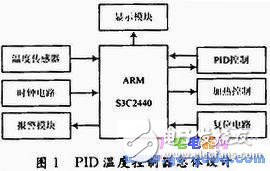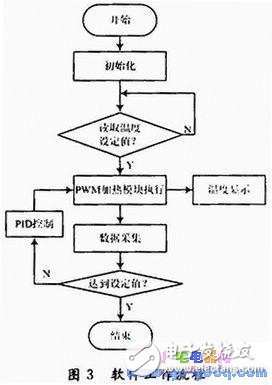In this paper, an embedded temperature regulator based on ARM microprocessor is designed for the problem of color temperature control in shadowless lighting system. The whole intelligent temperature controller consists of microcontroller, digital display module, temperature sensor, PWM heating module and clock. The circuit is composed of multiple components, and the PID adjustment circuit, serial communication circuit, microcontroller peripheral communication interface, PWM heating control circuit and software module are designed, and the whole software and hardware system is built. Finally, experiments and verifications are carried out. The results show that the embedded PID temperature controller can meet the design requirements, has good adjustment accuracy, and maintains the constant temperature control characteristics, which can be put into practical application.
The temperature controller is an important control device. Among the household appliances with sensitive performance requirements, the temperature controller is one of the necessary control systems, and it has broad application prospects in the fields of large-scale industry and daily life. In many application fields, high-precision thermostatic control is required. For example, according to external changes, the brightness of the corresponding LED can be adjusted at any time to achieve the desired color temperature value, so that better illumination and decorative effects can be achieved. The introduction of PID control in the temperature controller can obtain better control effects, and the temperature fluctuation can be controlled within 0-125 °C. The technology has been applied to products such as timed temperature control fermenters and health care pads, and has performed well and obtained good social and economic benefits. Therefore, how to introduce PID temperature control system in the color temperature control of shadowless lighting system has become one of the research topics, and with the development of modern computer technology, communication technology and digital technology, the introduction of embedded system in temperature control system has been Become a trend, it has the advantages of strong scalability, high integration, and precise control.
1 Overview of embedded temperature control system1.1 Embedded Overview
From the perspective of the composition of the embedded system, the embedded system is a computer system that integrates software and hardware and can work independently; from the appearance, the embedded system is more like a "programmable" electronic component; From the above, it is a controller that precisely controls the execution object to make it "smart".
The embedded system is mainly used for signal control. It is small in size and compact in structure and can be embedded as a component in the controlled device. It provides user interface, management information input and output, monitoring equipment work, making equipment and application products more intelligent and cost-effective. According to the IEEE (International Institute of Electrical and Electronics Engineers) definition, an embedded system is a device that controls the operation of a monitoring or auxiliary equipment machine or plant. It can be seen that this definition is mainly considered from the application side. The main difference between an embedded system and a general-purpose computer is that the application purpose is different. Whether in hardware or software, each embedded system is tailor-made for different applications or for specific functions. Consider more factors such as space costs.
The embedded system has strong specificity, high real-time and reliability, good cutability and low power consumption. The temperature controller based on embedded technology is easy to expand and powerful. It not only simplifies the system in hardware structure, but also improves performance, which can reduce the cost of the system for more flexible deployment of applications. Embedded is temperature regulation. The direction of development of the controller.
1.2 PID regulation principle
Proportional, integral and differential controllers are the most widely used regulators in engineering practice, referred to as PID regulators. PID control appeared in the 1950s and became one of the main technologies of industrial control, mainly because of its simple structure and reliable operation. Good stability and easy adjustment.
2 system design2.1 Overall hardware design
The embedded ARM temperature regulator designed in this paper mainly consists of the following modules: display module, temperature sensor, clock circuit module, alarm module, ARM core S3C2440, PID control module, PWM heating control touch, and reset circuit. The overall hardware design of the system is shown in Figure 1.

2.2 PWM heating module design
The PWM heating module consists of a 3524 chip plus some peripheral components. The rectangular wave is generated by the 3524 chip internal oscillator and its frequency is:
F≈1.30/(RT-CT) (1)
The potentiometer RT is used to adjust the frequency, and the pulse width modulator is composed of a differential amplifier, a comparator, an oscillator, and the like inside the 3524 chip. The rectangular wave duty cycle of its output is controlled by the differential amplifier output voltage.
2.3 PID circuit
The purpose of designing the PID regulator is to adjust the actual value of the control object to correspond to the new set value, which can reduce or eliminate the influence of the amount of interference. In the field of automatic control, due to the stability and reliability requirements of the control, the analog PID control technology is simple and reliable, the cost is low, and the application is widely mature. Figure 2 is a block diagram of the composition of the PID regulator.

In the control unit, the input signal Vi is PI, and the PD circuit performs a PID operation to obtain Vo.
The working principle of the PID regulator is: Vi is the temperature sensor to detect the deviation of the signal after the amplification process is compared with the set signal, and the regulator performs proportional, integral, and differential operations on the deviation amount, thereby outputting an appropriate control signal Vo. The next level of circuit causes the measured value signal to return to the given value to achieve the effect of automatic control. The three parameters (P, I, D) of the regulator are independently adjustable. In practical applications, the P, I, D parameters are determined by engineering tuning. The method is directly carried out in the test of the control system, and the method is simple and easy to grasp, and is widely used in engineering practice.
2.4 Software Design
The software module is very important in the temperature control adjustment system. Because there are many software systems in this paper, the modular design scheme is adopted, that is, the whole software is composed of many independent small software modules, and the small modules are connected through a specific software interface. Communication, modular structure by function. Its main work flow chart is shown in Figure 3.

Firstly, the controller parameters are initialized, and then the temperature setting value is read. If the acquisition is successful, the PWM heating module is controlled to execute; the temperature sensor module obtains the actual temperature and the set value for comparison, and if it is the same, it ends; if it is different, it is controlled by PID. To adjust the heating module until the same.
3 experiment and verificationAccording to the hardware design overall block diagram 1, the functional blocks are connected, the software is downloaded to the ARM system, and the temperature sensor DS18B20 is connected to the ARM controller through the serial interface to set up an experimental environment for experimental verification. When the set temperature is 50 °C, the operation result is shown in Figure 4.

When the set temperature is 90 °C, the operation result is shown in Fig. 5.
4 ConclusionThis paper designs an ARM-based PID temperature controller, which uses DS18B20 as the temperature sensor, communicates with the microprocessor through the serial port, the microprocessor adopts ARM S3C2440, and the heating module adopts PWM mode, which gives the overall hardware circuit and software workflow. Finally, experiments and verifications were carried out. The results show that the controller has high adjustment accuracy and can be used in industrial sites.
Energy(Vitamin cigarettes)
Energy(Vitamin cigarettes),vape nicotine free,vape nicotine,vape ice flavors
Shenzhen Aierbaita Technology Co., Ltd. , https://www.aierbaitavape.com